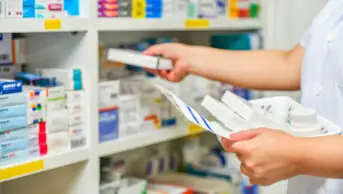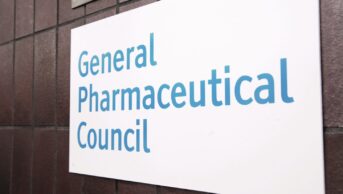This content was published in 2014. We do not recommend that you take any clinical decisions based on this information without first ensuring you have checked the latest guidance.
Summary
Ambulatory blood pressure measurement (ABPM) is a method used to monitor blood pressure over a period of time, usually 24 hours. Think of ABPM as blood pressure monitor fitted onto a patient that inflates and takes a measurement every half an hour automatically while the patient goes about their normal daily activities. ABPM is used to check for white coat hypertension (HTN), nocturnal HTN and effect of medication which is useful measurement in resistant HTN (difficult to treat HTN). It is also useful for checking response to treatment and also evaluation of symptomatic hypotension. One of the main indications for ABPM is when hypertension is suspected. In effect anyone suspected of hypertension should be offered ABPM to confirm diagnosis.
Community pharmacies are ideally placed for suspected hypertensive patients to have access to ABPM. It gives the patient more choice to get ABPM before confirmed diagnosis. It has been found to be cost an effective method as it saves on unnecessary drug costs (1). It should be offered to all patients suspected of hypertension as per NICE.
Background
NICE hypertension guidelines 2011 (CG127) states ABPM should be offered routinely to all patients suspected of hypertension. It has been found to be a cost effective method but the use of ABPM in diagnosis needs to be widened and encouraged. NICE quality standard 28 explicitly states that
“People with suspected hypertension are offered ambulatory blood pressure monitoring (ABPM) to confirm a diagnosis of hypertension”
One extra step of providing ABPM patient choice is through a community pharmacy based service. Countries such as Ireland and Italy have established ABPM clinics run from community pharmacies, they are a role model for hypertension diagnosis using pharmacies for the rest of the UK.
Consultation
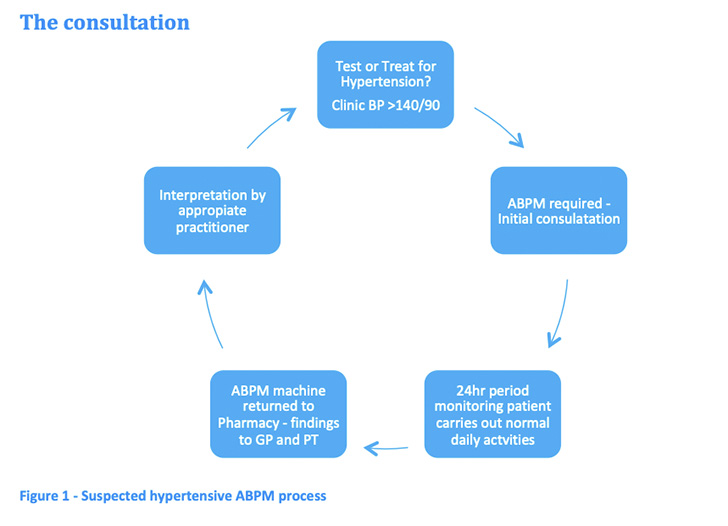
Fitting consultation 15–30 minutes
An initial consultation with the patient for assessment, which includes pulse regularity check, programming of ABPM machine and fitting on patient with subsequent counselling. Pulse check will involve skin to skin contact by placing fingers at the inside of the wrist and checking for a whole 1 minute. Any interval between pulses that increases or slows during the whole 1 minute needs to be rechecked and referred back to the GP for further examination as firstly the patient is not suitable for ABPM as the machine will not take an accurate pressure, secondly an ECG will need to be performed for AF investigation.
Advice sheets can be found on the BHSOC.org website. The info provided will help with scenarios such as what to do if the batteries fail? A one-off check should be performed now so that patient is comfortable and the readings are coming up, this is called a “casual” read. Patient should be advised how to switch off and also take off the cuff if needed, for example when showering. Patients should be reminded to avoid driving but where driving needs to be done as part of a normal routine, then the patient should continue as normal. Should the machine start to inflate while driving, patient must park up safely and legally until the measurement has completed. ABPM on motorways or long journeys is discouraged as there will be difficulty in trying to park safely and legally.

http://commons.wikimedia.org/wiki/File:Radial_pulse.jpg?uselang=en-gb.Checking for a regular pulse
Which arm?
Cuff should be placed on non- dominant arm unless there is a difference of more than 20/10 then use higher reading arm. If the patient’s non dominant arm is affected such as mastectomy surgery or stroke use the opposite arm. If the patient is taking warfarin explain to take off, if any signs of bruising appear. Any tight fitting jewellery should be removed, loose jewellery will not be affected. Avoid as much disruption to the patient. Explain to the patient, to take off monitor at night and put on same side or on bed, as to avoid being wrapped the neck at night. Latex free cuff should be used in latex allergy patients. Lastly explain the machine is not water resistant, otherwise the patient may walk into the shower with it bringing the whole APBM service to a standstill if you have only one machine.
24-hour period
During this period the patient will be continuing with their normal daily routine and must wear the machine for the 24-hour period. NICE guidance asks for 14 daytime readings but a 24-hour period is recommend as will find any “non-dippers”. Normotensive patients will have a dip in BP readings, a non-dipper will not which is associated with higher rate of end organ damage. Patient’s might wish to make a diary of what they are doing in the 24-hour period, but they should at least remember when the went to sleep and woke up.
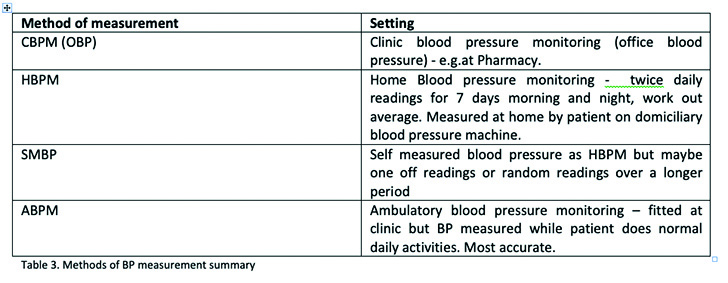
Review of results consultation (10–15 minutes)
At this point the machine will be taken off patient if not already done so. The readings should be looked at and see if you have full set of 24-hour readings, any abnormally out of place readings need to be checked with the patients diary. E.g. you might notice a one off reading of 170/100; the diary may explain that it was when the patient had an argument with the neighbour. Relay key information to patient, e.g. all BP readings were taken, which reading was unusually high, ask patient if any interval readings are missing.
Interpretation
This should be ideally left to the practitioner who is managing the suspected hypertension. Simple findings could be reported back to the patient at point of return. It would not be advisable to comment on whether a patient requires treatment or not, unless the pharmacist is appropriately trained to do so, e.g. an independent prescriber in hypertension or has good knowledge of the national guidance at least. Remember this is an ABPM measurement service and aim is to obtain BP results not to interpret and make a decision whether to initiate treatment or not. This could be adapted to a local service agreement depending on pharmacist’s advanced practice skills.

Communicating results
GP copy – send a copy of results to the GP practice, paper copy or electronically. Remembering most GP practices are called “paper light” which effectively means they prefer dealing with electronic correspondence.
Patient copy – hand over a paper copy. This is usually a PDF copy produced by the ABPM machine software, just hit the print button. The PDF can also be saved and forwarded on to an email address, remember patient data is included, so safe handling of patient data applies. Always consent to send paper or electronic copies and keep records for 2 years for clinical governance.
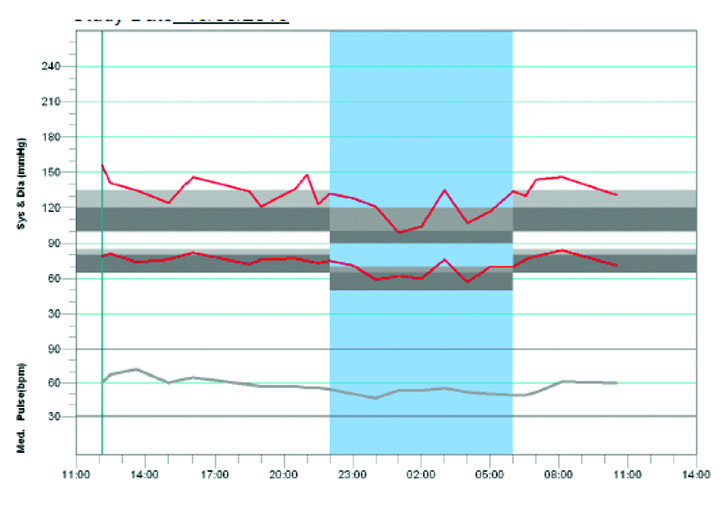

SOPS
Robust SOPS can be found available for use on the British hypertension website www.bhsoc.org. These can be adapted to local need.
Staff training
Training will be needed on how to program the ABPM machine for the patient and fit it onto the patients arm comfortably with appropriate sized cuff. Staff should be trained in counselling the patient and most importantly how to check for a regular pulse.
Provision to wash cuffs
Continuous use of cuffs on different patients especially for 24 hours will leave the cuff needing a wash. Most ABPM cuffs can have the inflatable pouch removed and the remaining cuff can be placed in the washing machine or appropriate manufacturers guidance on washing. As a service provider you must be have a system in place to have them washed. It may be inappropriate to buy a washing machine for the pharmacy but you may opt to get them washed off site. Using a cuff barrier between skin and cuff will help with hygiene, it is effectively a paper tissue wrapped around the arm and the cuff placed around it.
Costings
Consultation time costs
- 15–30 consultation programming, fitting and counselling
- 15–20 minutes for removal, interpretation and communicating results
One-off costs
ABPM machine plus cuffs, staff training time, set up time costs.
Maintenance costs
Washing cuffs, batteries, record keeping time costs (if commissioned may entail sending monthly info to commissioners e.g. CCG).
Private ABPM services are found in England and Ireland. Published prices on the internet range from 50 euros in Ireland to £160 for a nurse led service in South of England. It would not be feasible for an NHS subsidised service to fund £160 per each ABPM patient. In order for the service to be feasible and attractive to commissioners the price per patient should take into account consultation costs in other settings where ABPM is offered locally. In must be added that certain manufacturers are willing to provide a free ABPM machine per GP practice.
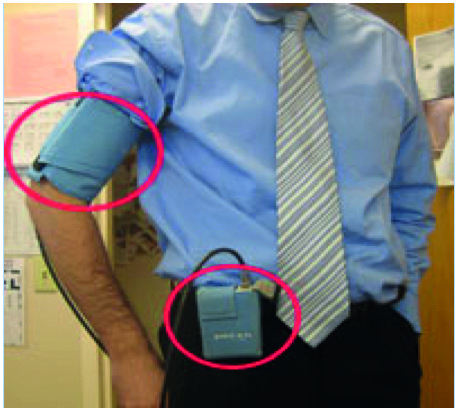
Photo: mvcardiology.com
Case study
Bill has been seeing the nurse practitioner Fiona at the GP practice next door. His CBPM is 158/96. Fiona recommends he have ABPM for a true “reading”. The practice only has one ABPM machine and there is a 3 month waiting time for next appointment for ABPM fitting. The local clinical measurements department at the hospital can provide ABPM too but patient is not keen on going to the hospital and having to wait for further appointments. Fiona recommends seeing Gary the pharmacist.
The pharmacist next door Gary provides a walk-in ABPM service at his pharmacy. Bill visits next door. The trained staff members are able to offer a walk in consultation, check his pulse for regularity, programme the machine and fit it using an appropriate sized cuff. He is given appropriate instructions and asked to return next day after the 24 hr. period. He is also given a diary sheet as to what he does during that 24 hr. period. It is a late night pharmacy and he returns on Saturday evening. He was at work so switched off the machine after the 24 hr. period and popped in to return the machine when it was convenient for him. Upon return the machine is returned, readings are uploaded on to the computer and three copies printed, one for pt., one for pharmacy and one for GP, he also agrees for results to be emailed to the GP practice manager. Gary is able to see Bill in the consultation room and notices his Average BP is 134/72. Gary points out the findings and re assures Bill and recommends a follow up apt with nurse Fiona to confirm subsequent management.
Bill enquires about having his wife’s blood pressure checked the same way too as he knows that she gets worked up when she has it checked away from home. While there he asks for advice on a good blood pressure machine for home and ends up buying one too. Bill really appreciates the service as it saved him from taking tablets to control his suspected hypertension and now recommends it to his friends and family to get it checked this way round.
References
- National Institute for Health and Clinical Excellence. Clinical guideline 127-Hypertension. June 2011. http://guidance.nice.org.uk/CG127 (accessed 6 January 2013) National Institute for Clinical Excellence.
- Quality statement – Hypertension March 2013. http://publications.nice.org.uk/quality-standard-for-hypertension-qs28 (accessed 6 January 2013)
- British Hypertension Society. ABPM resources (accessed 6 January 2013)
- British National Formulary. Online www.bnf.org (accessed 6 January 2013)

